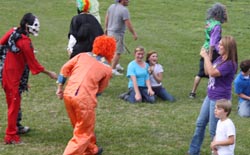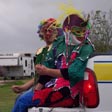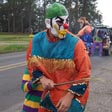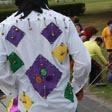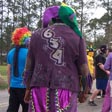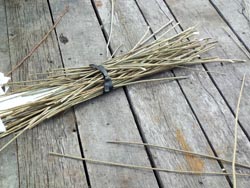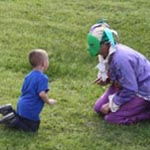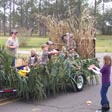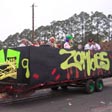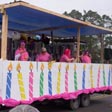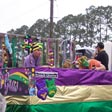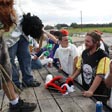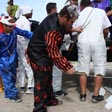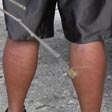A Study of Tradition and Change in the Gheens Mardi Gras
By Maria Elise Zeringue
For over a century, the people of Gheens have celebrated Mardi Gras with a whipping ritual locally called "the chase," in which men of the village "dress out" in colorful masks and disguises to chase and symbolically whip local children and teens. This celebration differs from the better-known courirs de Mardi Gras (Mardi Gras runs) of rural southwest Louisiana, which are processions of masked riders who beg for chickens and other gumbo ingredients and sing, dance, and clown for their hosts in return.
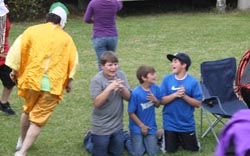
Gheens—sometimes called Vacherie by older residents—is a small village of roughly 2,000 people located in Lafourche Parish, approximately 28 miles south of Thibodaux.1 Gheens is one of only two southeastern Louisiana communities that still practice the traditional Mardi Gras chase.2 The history of this region's rural Mardi Gras customs has not been fully documented, so there is no written account of the chase's history in the Gheens area. However, community members' oral histories and memories trace it back at least to the turn of the 20th century. When I asked residents of the village about the chase's beginnings, I received many responses similar to what Mark Breaux had to say on the subject: "There's different stories on how it got started. My great-grandfather was born in 1885 and from stories that he told us, it was here when he was growing up, so how long it's been going on, I really can't say. It's hard to find an answer from anyone in the community of exactly when it got started and why it got started."
The oldest person in Gheens, Melva Cressionie, currently in her nineties, also remembers hearing stories about the Mardi Gras from her mother. She explains: "Pour des années, il y avait le Mardi Gras dedans la Vacherie. Je connais pas équand ça a commencé, mais équand ma mère ëtait petite, une 'tite enfant, il y avait des Mardi Gras. Elle est morte. Elle avait quatre-vingt-quatorze ans, so she was 94, and she's been gone for 14 years." ["For years, there was the Mardi Gras in Vacherie (Gheens). I do not know when it started, but when my mother was little, a little child, there were the Mardi Gras (maskers)]" (Cressionie 2011).3 The memories of Gheens residents, then, indicate that the whipping ritual has been a continuous part of their Mardi Gras festivities for many years. In addition to its local history, the celebration's roots can also be placed in a larger historical context that dates back to medieval Europe and shares similarities to ancient Greek and Roman flagellation rituals (Fabre 1992: 24, 38-39; Kinser 1990: 3-6; van Gennep 1947: 886; Tallant 1948: 84).
The history of the Gheens Mardi Gras chase, and its continued vitality today, illustrate that the Louisiana rural style of Carnival belongs to both ancient and modern traditions (Lindahl 1996b: 125-126). Although rooted in the past, the custom is always evolving and being re-shaped by its current practitioners. Scholars have noted similar kinds of adaptations in rural Mardi Gras runs (courirs) in southwest Louisiana. For example, after the Mamou Mardi Gras run was discontinued during World War II, Paul Tate and Revon Reed revived the event in the 1950s, updating it by adding more structure and rules (Ancelet 1992). Similarly, some Cajun Mardi Gras runs switched from horseback transportation to trucks in the postwar years (Ware 2007: 14). One of the biggest changes took place in the 1960s and 1970s, with the emergence of co-ed and women's Mardi Gras runs in several rural communities in southwest Louisiana (Ware 2007). Describing modifications in the Basile Mardi Gras courir in recent decades, folklorist Carl Lindahl commented on Louisiana's rural Carnival: "As the demonstrably ancient form of Mardi Gras absorbs the newest cultural developments and changes shape to accommodate them, the clash between the archaic and the contemporary is visible everywhere within the celebration" (1996b: 131).
Focusing predominantly on the last forty years, this essay explores change and negotiation of tradition in the Gheens Mardi Gras. In Gheens, no other cultural development has brought about more rapid change than the addition of an urban style Carnival parade.4 In particular, I examine how the local community has adapted their traditions to accommodate a small float parade that begins at eleven o'clock on Mardi Gras morning, followed by the chase at two o'clock that afternoon. I first consider the social and cultural context of these modifications to the local Mardi Gras festivities, and end with a study of two major changes put in place by local participants.
The Chase in Gheens
Before I begin to fully address the objectives of this work, it is necessary to describe the ritual as it happens today. Above all, the country Mardi Gras celebration is a community event, so it is fitting that the route of the Carnival procession traces the boundary lines of the neighborhood (Lindahl 1996b, Ware 2007). The town is arranged in a linear fashion along Louisiana Highway 654, the only main road that passes through the town.
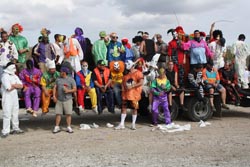
The highway reaches a dead end just before the grounds of the Golden Ranch Plantation, past the Company Canal; thus, the sole entry point into Gheens also serves as the only point of exit. Because the community is designed more or less in the shape of a line, the locals often use linear frames of reference such as "the front" and "the back" to describe their whereabouts in town. The front of Gheens refers to the area near the beginning of the housing settlements along Highway 654, about two miles from the intersection of Highway 654 and the main road, Highway 308. The back of Gheens describes the area near Highway 654's dead end, just before the Company Canal.
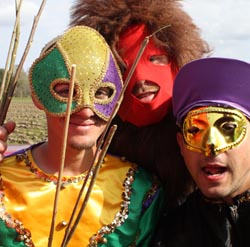
On Mardi Gras day, the flatbed trailer carrying the disguised participants (also called the Mardi Gras) traverses Highway 654 from one end to the other. Before the chase commences, the Mardi Gras gather together in an open field in the back of the village near the Company Canal and the old Gheens family plantation. Here, in an effort to preserve their anonymity throughout the day, they dress in their costumes away from the crowds. Once the Mardi Gras are dressed and new participants are initiated, the masked men board the trailer and make their way to the front of town to Kearney Toups' house, the official starting point of the chase.
As the trailer proceeds along the highway towards the Toups house, the Mardi Gras are finally revealed to the neighborhood for the first time, and anticipation builds among the participants and spectators. The Mardi Gras are dressed in brightly colored costumes with bells sewn on their sleeves, and each participant wears a mask that is either home-made, ghoulish and Halloween-style, or borrowed from the urban Carnival parades of previous years.
As they ride, the maskers tap the supple willow branches used as whips along the trailer's sides as a playful warning to the children, who know that the Mardi Gras will soon be descending to chase and whip them. The tapping of the whips, the jingling of the bells, and the maskers' teasing create a carnivalesque atmosphere that electrifies the public and provokes an array of reactions. Some of the braver children take this brief opportunity to tease the Mardi Gras without being whipped. They cry back at the Mardi Gras: "You're not going to catch me!" or "You're too slow!" Others laugh and wave at the Mardi Gras as they pass, and a few little children even cry at the sight of the masked band of men.
On reaching the Toups house, where a large group of family and friends waits for the chase to begin, the Mardi Gras climb down from their trailer. According to the traditional rules, the children (and sometimes adults) along the side of the road must get on their knees and say "Pardon! Pardon!" (which means "pardon me" in Cajun French) as the Mardi Gras approach, or risk being chased and whipped.
Some children immediately fall to their knees, while others try to run away from the whips. The Mardi Gras are careful not to actually hurt those they whip; after all, the custom is intended to celebrate the community through shared laughter and play. Mardi Gras flogging in Gheens is largely symbolic, especially when small children are involved. When the Mardi Gras whip older children and adolescents, they deliver, at most, a light tap on the backs of their legs. After the masked men have chased most or all of the children at the first house, they move on to the next predetermined point along the route. This communal performance is repeated at various stops throughout the day.
The Parade
The Gheens Mardi Gras chase has continued to thrive and slowly evolve over the past century. But when the urban-style float parade began forty years ago, changes (discussed more specifically later in this essay) had to be made in order for the float procession and the chase to coexist successfully. The community's Jaycee Club inaugurated the parade in 1973 because many local children did not have opportunities to experience Mardi Gras celebrations in cities such as Houma and New Orleans. According to Earlene Breaux, one of the parade's founders, the float procession in Gheens offered the children and their parents a convenient chance to catch beads and watch the floats pass by in their own neighborhood. The parade is small in comparison to nearby festivities in Thibodaux and Houma, where the number of floats for each Carnival event varies between twenty and fifty. Over the forty-year history of the Gheens parade, the number of floats has fluctuated from year to year, but the average number falls between ten and twelve. Like the Mardi Gras chase, the floats begin their procession at the front of Gheens near Kearney Toups' house, and end at the back of town, near the last group of houses before the Company Canal.
The Folkways vs. the City ways
The parade's inclusion in local Mardi Gras festivities, alongside the traditional chase, represents what anthropologist Robert Redfield calls the intermingling of two styles of life: urban and rural (1964: 130-131). In his book The Little Community, Redfield proposes that ways of living associated with the village and the city respectively are vastly different from each other, creating a frontier between the rural folkways and the city ways. He further suggests that once the frontier between village and city is crossed, and the urban world encroaches upon the rural, a period of adjustment takes place within the village (1964: 131). In the context of Mardi Gras, the float parade represents city ways, and the chase represents rural folkways. In much the same way that city is different from village, the rural chase and the urban style parade are distinguishable from each other in both practice and in meaning. The merger of these two differing genres of Mardi Gras on the same day has occasionally resulted in adjustments to the rural ritual, in order to incorporate the urban tradition into Gheens' Carnival festivities.
Contrasting Carnivals
The biggest difference between these two modes of Mardi Gras lies in their degree of intimacy. Traditionally, the rural Mardi Gras chase in Gheens is a celebration of community; it represents an old social model of communal living that folklorist Barry Ancelet calls the petit monde or the little world (2001: 144). During the period of the little community—which lasted from the Acadians' arrival in the region in the late 18th century until the second World War—rural Cajuns lived in "womb-to-tomb" communities, and they did not venture far from where they were born (David 1999). Consequently, neighboring communities were isolated from each other and thus developed their own cultural variations. The isolation and quasi-autonomy of each community led to an outsider-insider dichotomy that still lingers today throughout south Louisiana. In addition, the members of the village typically relied upon cooperation and a reciprocal system of exchange for survival during the petit monde era, when assistance from state and government institutions was scarce or non-existent (David 1999; Ancelet, Edwards, and Pitre 1991: 45-46, 50-51).
On Mardi Gras day, the Gheens community gathers to celebrate their solidarity and interdependence by visiting with each other and creating informal comical performances at the houses of their neighbors. Carl Lindahl has written about the ways in which Mardi Gras runs in southwest Louisiana symbolically express the communal interdependence once imperative to group survival, through the chicken chases and begging that are traditional there (Lindahl 1996b: 130). In Gheens, the celebration includes neither begging rituals nor a communal gumbo. Instead, it requires that the men in the village playfully whip the children in order to purge their sins. In addition, the Mardi Gras chase enacts the interdependence of the petit monde, where the entire village participates in raising a child. This Mardi Gras performance symbolically assures the continuation of the community, because the purging of transgressions represents the development of the young members into responsible adults. As participant Jeremy Breaux explains: "The tradition is, you say 'pardon.' It means 'pardon me' in French, and basically you [are] asking the Mardi Gras, 'pardon', and the Mardi Gras [are] whipping you to whip the sins out of you before the start of Lent." Furthermore, a younger Mardi Gras in his early thirties, J. D. O'Gywnn, adds that the continuation of the chase in Gheens is primarily dependent upon the younger generation taking an active leadership role once their older relatives and neighbors retire their masks. As O'Gwynn states, the past few years have been a transitioning period for the younger generation to take responsibility for the organization of the Mardi Gras: "Well, like this year, we didn't have too many of the older guys there. We usually let them take charge of it, and they've been doing it for so long, but this year none of them was really there. It was kind of left up to us, so me and Jeremy Breaux and Heath Breaux and all, we kind of stepped up and said well, we needed to do it, and kind of came up with a plan."
As an event, the Mardi Gras chase is inherently more intimate than the float parade. The act of whipping requires a close personal interaction between participant and spectator, and this interaction creates a sense of communal bonding (among insiders, at least). The majority of the whipping is symbolic, but the play may become more intense when it involves a Mardi Gras and a spectator who know each other very well. In Gheens, most Mardi Gras participants know the majority of the people standing on the side of the road, which makes for a spirited and often entertaining show. In contrast, the urban Mardi Gras parade tradition seems to place less emphasis on community bonds. During the urban celebration, the masked float riders throw beads to a crowd of people standing in the streets, which does not allow for much close human contact between the spectator and the participant. This is not to say that the urban style parade completely lacks a communal component, especially in some of the less heavily populated towns where Mardi Gras festivities operate on a smaller scale (de Caro 1999). In general, though, the parade is less intimate than the rural chase.5
Still, Gheens residents do enjoy the parade because everyone can participate. In the chase, only men can "mask out" and be Mardi Gras, whereas in the parade, men, women, and children ride in the floats and toss beads to the spectators. The parade has now been a part of the Gheens Mardi Gras celebration for four decades, because it is a fun event, and the small community is a close-knit one. Gheens resident and parade participant Hansen Breaux illustrates this point:
It's kind of over before it starts, but it is a really good time even though it's not that far, because you know everybody. . . .[In] the bigger parades, you'll see the floats when somebody knows somebody, they bomb that one spot. Where in Gheens . . . you almost have to limit yourself to doing that because you know everybody. And if you bomb everybody, like, you run out of beads half way to the parade. For local spectators, the parade is attractive because they can catch beads from their friends and family, and since many people in the crowd know some of the riders well, they are assured of being the target of a "bomb" of beads at least once during the parade.
The Parade and the Arrival of Outsiders
The Gheens parade is also attractive to outsiders from Raceland, Lockport, Mathews, and neighboring communities because of its reputation as a family-friendly parade. According to Earlene Breaux, people from outside of the community like to watch this parade because it is short—it typically lasts less than an hour—and participants can afford to throw lots of beads to onlookers because the route is not long. A retired Mardi Gras, Tony Breaux, summarizes the parade's popularity with outsiders: "They throw a lot, and that's why a lot of people come. They can make this parade, and their kids can catch more back here than what they'd catch at four other parades. So you know, [it] is nice that they can do that, but in the meantime, it kind of messes up our old tradition." Tony Breaux's response reveals the mixed feelings that many people in Gheens have about the parade. Despite the parade's popularity and success, the locals who actively participate in the Mardi Gras chase feel that the parade is one of the major catalysts for change to the whipping tradition, as some outsiders who come to watch the parade stay in town to observe the chase as well. Mark Breaux elaborates:
There was no parade back here, so the Mardi Gras was more or less a community-based activity. And then once the parade started, it started bringing outsiders in that weren't familiar with the culture and the tradition back here. And that's, I would say, within the last twenty years is when we started having a little trouble with outsiders coming here and not wanting to take part in activities and so forth.
Tony's and Mark's comments, which exemplify the attitudes of many townspeople in Gheens, reflect intensely local notions of community and identity in south Louisiana, a result of the petit monde's territorial social structure (Ancelet, Edwards, and Pitre 1991: 105). Many participants and their families are very proud and protective of their tradition; for them, it holds a much deeper significance than the partying and apparent chaos of the chase. For more than a century, Mardi Gras has been a day for Gheens residents to celebrate community solidarity through this ancient whipping ritual. Consequently, many locals, especially the core participants, would prefer that the chase remain an intimate celebration for the people of Gheens. They worry that the presence of outsiders, encouraged by the openness and public nature of the parade, will diminish the communal aspect of the chase (Mark Breaux 2011, Tony Breaux 2012, and Hansen Breaux 2012).
Nevertheless, it is important to note that townspeople are extremely welcoming to folklorists, journalists, and outsiders who respect their Mardi Gras tradition. These days, some of the younger participants invite their friends from neighboring towns to "dress out" and run with them. However, insiders to the ritual become frustrated when outsiders observe the chase without being willing to understand the inversive rules of Carnival. Misunderstandings have arisen over the symbolic flogging of children and teens that is the main act in this carnivalesque drama. For insiders, the whipping ritual is playful and consensual, but it has the potential to be overwhelming and offensive for spectators without any contextual knowledge of the festival.
A Study of Carnival Adaptations
In his discussion of the evolution of the Basile Mardi Gras run, folklorist Carl Lindahl states, "These and other changes in Cajun lifestyle have made their marks on Mardi Gras, because this festival, like any other living tradition, has changed with—and in ways reflective of—its community" (1996b: 131). Similarly, the people of Gheens have adapted their Carnival tradition to accommodate the specific needs of their community. The previous section of this article discussed the context of these changes; the remainder focuses on two ways in which active participants and supporters of the Gheens chase have negotiated certain aspects of the ritual.
Carnivalesque Play
As more outsiders have begun visiting Gheens to watch the parade and stay for the chase, the Mardi Gras have developed a code of conduct that tones down the older, wilder style of performance, in order to decrease the likelihood of offending visitors. A Mardi Gras in his thirties, Freddy Breaux comments that for visitors, "It's gotta be a little scary to have ten guys run around, you know, on top of you with switches whipping your butt." He adds, "So you gotta be kind of sensitive to the fact that they might not realize that it's all in fun and they might get offended. You know, if they do, let 'em go. You know, that's the whole deal." Rowdy play aimed at onlookers is at the heart of the Gheens Mardi Gras celebration; the chasers depend on spectators' willingness to participate, because otherwise there would be no one to whip. This externally directed play creates what Lindahl calls participant-observers, who are playfully pulled into the performance, and during the chase, it is obligatory for all observers along the road to participate (1996a: 62).6 Before the introduction of the parade forty years ago, observers consisted of families and friends who grew up in Gheens and were therefore familiar with the tradition. Mark Breaux says, "It was common knowledge that if you were from back here on Mardi Gras day, if you were a kid, you were going to get chased. Either that or stay locked up in the house all day long. That was your only choice." People understood that if they stood on the side of the road during the Mardi Gras celebration, they were expected to play, which still holds true today. Generally speaking, the majority of the spectators are willing participants; however, there are occasions when the Mardi Gras pull observers into the game despite their reluctance to play. Forcing spectators out of their comfort zones has long been a part of the inversive nature of the carnavalesque tradition in Gheens.
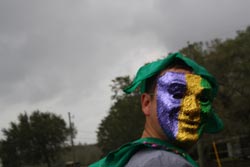
In addition, the intimacy and isolation of the petit monde communal setting allowed the Mardi Gras the freedom and the time to chase the children throughout the entire community, an area that extends beyond the predetermined Mardi Gras route. In the past, the transgressive performance often involved invading the personal property of community members throughout the day. Mardi Gras went into people's homes and barns; they shook cars and grabbed people out of cars in order to find children trying to hide from their switches. Local residents also participated by letting the Mardi Gras into their homes, or even letting the maskers break down their doors or windows to find the hiding children. The Mardi Gras knew all of the people who chose to be chased; therefore, the closeness and mutual understanding among community members permitted a style of play that was considerably rougher and more intense than it is today. This story from Mark Breaux illustrates this point:
Mr. Manny, his grandkids were in the shed in the back, and he came out of the back door and said, "What's the problem?" [Someone] said, "They're locked in the shed." [Manny] said, "Pull the door down, I'll fix it later." And then Mrs. Molly Dominique did the same thing. Her daughter and her niece were in the shed and they were teasing us through the windows, and she said, "What's the problem?" She said, "Anne and Karen are in the shed, they have the door locked." She says, "Pull it off. Mr. Dudley will fix it later."
In today's Mardi Gras these events can still take place. For example in 2012, on two separate occasions I observed homeowners inviting a group of Mardi Gras to enter a home to chase some children seeking refuge there. The second time that I saw this happen, one Mardi Gras even climbed through a window of a mobile home to get to a few young ones hiding inside. However, moments like these—reminiscent of the stories that the younger generation has heard from their parents and grandparents—do not happen quite as frequently as they did in the past. Now more people are outside waiting for the Mardi Gras, and the parade leaves less time for the chase. Tony Breaux explains that in the past, "it was mostly a lot of people from back here . . . and they knew most of the Mardi Gras that was out there. . . . As you get more people, things just change a lot."
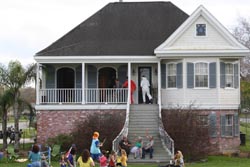
The present generation of Mardi Gras has to anticipate the fact that there will be people on the side of the road who are not accustomed to the Gheens tradition. Many of these younger participants say that they have to find a middle ground that balances the older tradition of wild Mardi Gras behavior described by their parents and grandparents with the contemporary discomfort regarding corporal punishment. For this reason, they only lightly tap the majority of the people on the side of the road. A light, symbolic tap, especially on outsiders, does not compromise the whipping tradition, and the flogging is gentle enough to not offend those who have discovered the Gheens chase for the first time. The following quote describes local Mardi Gras changes over the past twenty years from the perspective of Freddy Breaux, a veteran Mardi Gras in his early thirties, based on what he has witnessed and on what older generations of Mardi Gras have described:
Yeah, I would say it's not as aggressive now. I guess I could say aggressive, but you know it used to be a little bit more open and I think it was because more people knew each other. You know, the Mardi Gras knew the people who were on the side of the roads . . . . Now, there's a lot of people who you don't know on the side of the road, so it's not quite as personal. And it used to be if you came in the house, they were coming in the house. If you went in a car, they were getting in a car. You know, if you were trying to drive out of Gheens, they can stop the car, and they can get you out of the car. So now, because of so many people from outside of Gheens being part of the parade and coming to see the parade and wanting to see the Mardi Gras and all, we had to kind of back off on things like that just to make sure that it doesn't cause too much trouble. You know I mean when you start hitting on somebody's car with a switch or, you can damage somebody's property, you can injure somebody, and then you might not be able to run next year, you know. So basically I find it's not quite as track-down-every-kid-no matter- where-they-go. It's kinda, we'll run, we'll whip the kids who wanna be whipped. If they're way in the back and they're half a mile down the pasture, we're not gonna go run 'em down to go catch 'em, you know. But in the past, I've heard stories of people swimming the canals, which is . . . it's all the way at the back of this street.
The Rite of Initiation
In addition to gradually toning down the play, leaders of the chase and some retired Mardi Gras have instituted an initiation for all new Mardi Gras just before the chase begins. Boys in the community have the right to chase at the age of sixteen, but first the older runners must initiate them. Incoming runners older than sixteen must also be initiated before they can whip the spectators. As Mark Breaux indicates, there is no exception to this rule: "If they don't do that, they don't chase. If they are not willing to go through an initiation to see how it feels, they don't chase. It doesn't matter who they are." The initiation takes place in an open pasture near the Company Canal, the same location where all of the Mardi Gras change into their costumes. Experienced Mardi Gras line up all of the new participants along the sides of the trucks or the flatbed trailer that will transport them during the chase. Once the initiates are lined up, the previously-inducted men take their turn giving each new Mardi Gras two strikes on the backs of their legs. The first blow shows the new participants how not to flog children and spectators, because it uses more force than is acceptable during the chase. Caleb Breaux says that he gives the newcomers "a nice whack to show them how it's not supposed to be." The second strike is a light tap that provides a good example of how to tap the spectators. Like the chase itself, this initiation is not intended to hurt the new Mardi Gras; it is a playful performance that entertains both veteran and incoming participants, and educates novices about the limits of appropriate play.
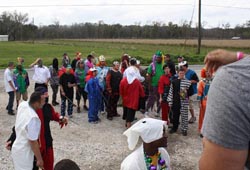
The leading members of the chase created this initiation some years after the parade was introduced, as maskers from outside of the community began to participate in the chase. These newcomers from neighboring towns were typically friends and relatives of Gheens residents, who invited them to take part. Many of the new chasers had never witnessed the whipping ritual. The initiation serves as a brief demonstration of proper Mardi Gras behavior, showing them how to have fun within the rules and structure of the chase, and most importantly, how to use the whip in a way that does not harm the spectators. The whips are thin, supple willow branches, cut by participants prior to the chase; they are about eighteen inches long and do not exceed the width of a pencil. Because the whipping is only meant to entertain family and friends of the children, teens, and adults who spiritedly succumb to the masked men, the whips cannot do any real harm. However, they can sting if a person whips hard enough. For this reason, retired Mardi Gras Brad O'Gwynn explains: "You had to let them [outsiders] know. They didn't grow up in that environment." As O'Gwynn suggests, when the group of Mardi Gras consisted only of young men who were raised in Gheens, there was no need to have an initiation rite, because the local teens modeled their behavior on the performances of their parents, friends, and relatives. Now that people from outside of the community participate in and observe the chase, the initiation is a proactive measure to prevent possible conflict as a result of inappropriate Mardi Gras behavior, such as harsh whipping. Carnival, with all of its reversals and wild revelry, teeters on the edge of what is socially acceptable and what is taboo. The initiation illustrates the paradoxical nature of the Gheens Mardi Gras; during this moment, the new participants—by sting of the switch—vow to fulfill their role, which is to find a balance between chaos and control, between seriousness and frivolity.
as part of the rite of initiation before the start of the chase.
The initiation ritual, which began as a way to show outsiders how to play the game, is now a venerable part of the tradition that many of the community's young men keenly await. For outsiders, the initiation is a practical, fun, and intense introduction to the Gheens style of Carnival. For insiders, it represents a rite of passage necessary to become a Mardi Gras, marking the final culmination of the whipping and chasing that they had to undergo as children. In addition, for the young men in the community, the rite of initiation symbolizes their transition into adulthood. As with many rites of passage, the initiation is an experience of mixed emotions. The new Mardi Gras are sometimes nervous beforehand because they do not want to get whipped too harshly. On the other hand, they are excited and enthusiastic about being initiated, because many have waited years to finally be able to dress out with their older relatives and friends. Caleb Breaux describes his feelings during the initiation:
I mean when you growing up, I mean, being that young and always running from them, you always wanted to be one. . . . Well it was exciting; I mean I felt privileged because I was always into it. I mean, you know, it's in my heart. It's in our culture here. We always want to keep the tradition alive, but man when you sixteen and you['re] finally able to be a Mardi Gras, it's really exciting at that age.
As Caleb indicates, the initiation rite represents the perpetuation of the tradition from one generation to another, and it marks the moment when the young men become new guardians of the tradition in Gheens. Through the whip of the switch, the initiated are baptized into the group of Mardi Gras, and finally the torch is passed onto the new masked members. They have learned how to behave as Mardi Gras, and they have earned the right to entertain their community and be models for future Mardi Gras.
Change is an inevitable consequence of a living tradition, especially one as old as the Mardi Gras. For the younger generation chasing the children now, their Mardi Gras experience has always been, as Hansen Breaux says, "a package deal" that includes the parade and the chase. From their perspective, many of the changes over the past twenty to thirty years do not seem as drastic as they appear to some of the older members of the community, who are understandably nostalgic for the chase they remember from their youth. Despite the adaptations resulting from the parade, the time constraints, and the arrival of outsiders, participants and their supporters, both young and old, still enjoy and eagerly look forward to this day year after year. Likewise, the initiation rite is an example of how a new addition to a longstanding tradition can foster a positive sense of belonging and bonding among new and seasoned Carnival participants. As a living tradition, the Mardi Gras is simultaneously preserving the most important elements of the ritual and adapting to meet the needs of the contemporary world. As the Carnival of Gheens evolves, the one aspect that does not change is the strong significance that this tradition holds for the community.
Notes
1. Glen Pitre's 1992 essay "Mardi Gras Chase" offers a description of the Gheens chase in the early 1990s. According to Pitre, French-speaking residents told him that they call their community la vacherie (or cattle ranch), and insisted that Gheens properly referred only to the plantation at the end of the highway (1992: 44).
2. The other community is Choupique (sometimes spelled Choupic), also in Lafourche Parish. The Mardi Gras chase in Choupique is similar to the Gheens tradition. For a more detailed description of the Choupique Mardi Gras ritual, see Madeline Domangue Cagle's article, "Neither Spared nor Spoiled: The Mardi Gras Chase in Choupic, Louisiana," published in the Louisiana Folklore Miscellany in 1996.
3. English translation by the author.
4. The term Carnival refers to the season of festivities before the start of the Lent, which begins on Twelfth Night (the Epiphany in the Catholic calendar) and lasts until Fat Tuesday, or Mardi Gras. The term Mardi Gras specifically applies to the events taking place on the Tuesday before the first day of Lent, which falls on Ash Wednesday (de Caro 1999). In south Louisiana these terms are generally used interchangeably in conversation; therefore, for the purposes of this essay, Carnival also refers to the rituals taking place on Mardi Gras day.
5. In New Orleans, for example, Mardi Gras is heavily promoted to tourists and helps to boost the local economy during the season.
6. The term "participant observers" is one typically applied to ethnographic researchers.
7. The content of this essay has been adapted from chapters of the author's Master's thesis originally written in French, and from presentations given by the author at the American Folklore Society Annual Meeting in New Orleans in 2012 and the Louisiana Folklore Society in Baton Rouge in March 2013.
Sources
Ancelet, Barry, Jay Edwards, and Glen Pitre. 1991. Cajun Country. Jackson: University Press of Mississippi.
Ancelet, Barry. 2001. Falling Apart to Stay Together: Deep Play in the Grand Marais Mardi Gras. Journal of American Folklore 114.452: 144.
______. 1992. Singing Outlaws and Beggars with Whips: Variety in the South Louisiana Mardi Gras. Paper presented at the American Folklore Society Annual Meeting.
Breaux, Caleb. 2012. Interview by author, 12 April.
Breaux, Earlene. 2012. Interview by author, 13 April.
Breaux, Freddy. 2012. Interview by author, 13 April.
Breaux, Hansen. 2012. Interview by author, 12 April.
Breaux, Mark. 2011. Interview by author, 20 August.
Breaux Jeremy. 2012. Interview by author, 10 April.
Breaux, Tony. 2012. Interview by author, 10 April.
Cagle, Madeline Domangue. 1996. Neither Spared nor Spoiled: The Mardi Gras Chase in Choupic, Louisiana. Louisiana Folklore Miscellany 11: 11-28.
Cressionie, Melva. 2012. Interview by author, 8 November.
David, Dana. 1999. Le voisinage: Evolution of Community in Cajun Country. Louisiana Folklife Festival Booklet. Louisiana Folklife. City of Monroe, Louisiana.
de Caro, Frank. 1999. The Varieties of Mardi Gras. Louisiana Folklife Festival Booklet. Louisiana Folklife. City of Monroe, Louisiana.
Fabre, Daniel. 1992. Carnaval ou la fête à l'envers. Paris: Gallimard.
Kinser, Samuel. 1990. Carnival American Style: Mardi Gras at New Orleans and Mobile. Chicago: University of Chicago Press.
Lindahl, Carl. 1996a. Bakhtin's Carnival Laughter and the Cajun Country Mardi Gras. Folklore 107:62.
______. 1996b. The Presence of the Past in the Cajun Country Mardi Gras. Journal of Folklore Research 33.2:125-126,130-131.
O'Gwynn, Brad. 2012. Interview by author, 12 April.
O'Gywnn, J. D. Interview by author. 12 April.
Pitre, Glen. 1992. Mardi Gras Chase. Louisiana Life 12(1): 54-60.
Redfield, Robert. 1964. The Little Community as a Whole. The Little Community: Viewpoints for the Study of a Human Whole. Chicago: University of Chicago Press.
Tallant, Robert. 1948. Mardi Gras. Garden City: Doubleday & Company.
Van Gennep, Arnold. 1947. Manuel de folklore français contemporain. Vol.1. Paris: Picard.
Ware, Carolyn. 2007. Cajun Women and Mardi Gras: Reading the Rules Backward. Urbana: University of Illinois Press.
Zeringue, Maria. 2013. Le Mardi Gras à Gheens: Une étude sur son histoire, sa pratique et son évolution. (Master's thesis).
______. 2012. The Negotiation of Tradition and Change in the Gheens Mardi Gras. Paper presented at the American Folklore Society Annual Meeting.


